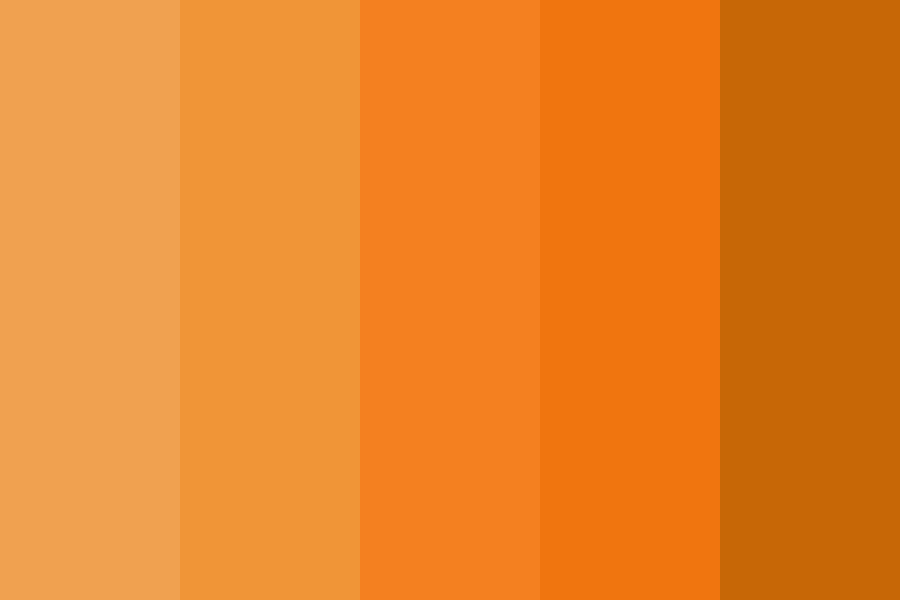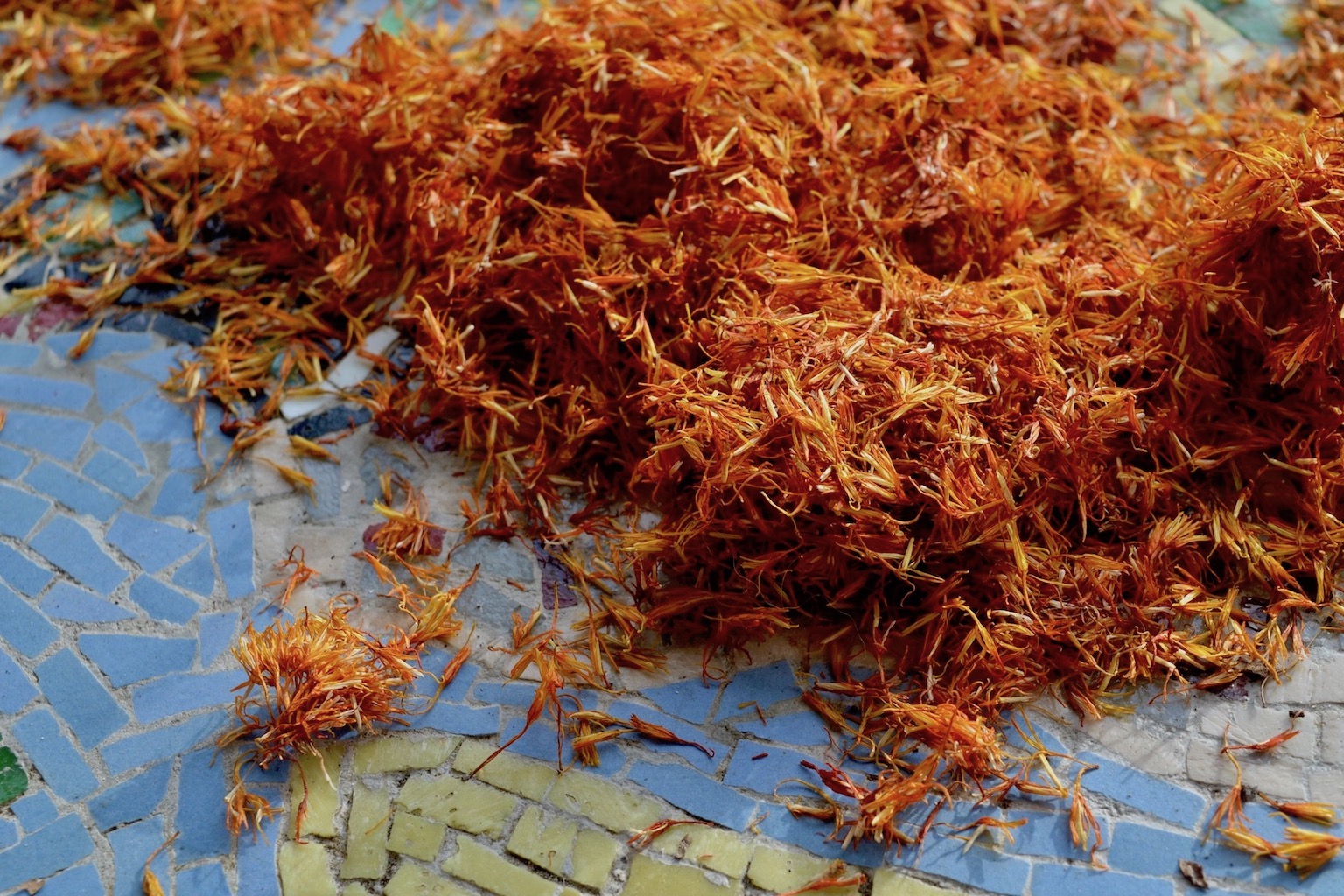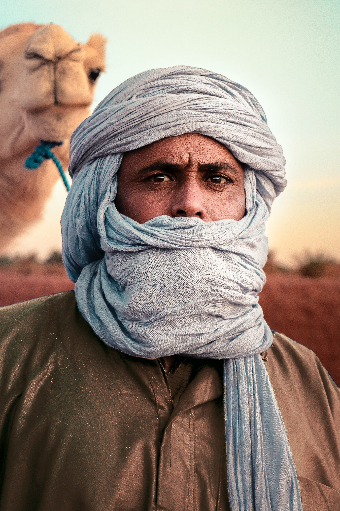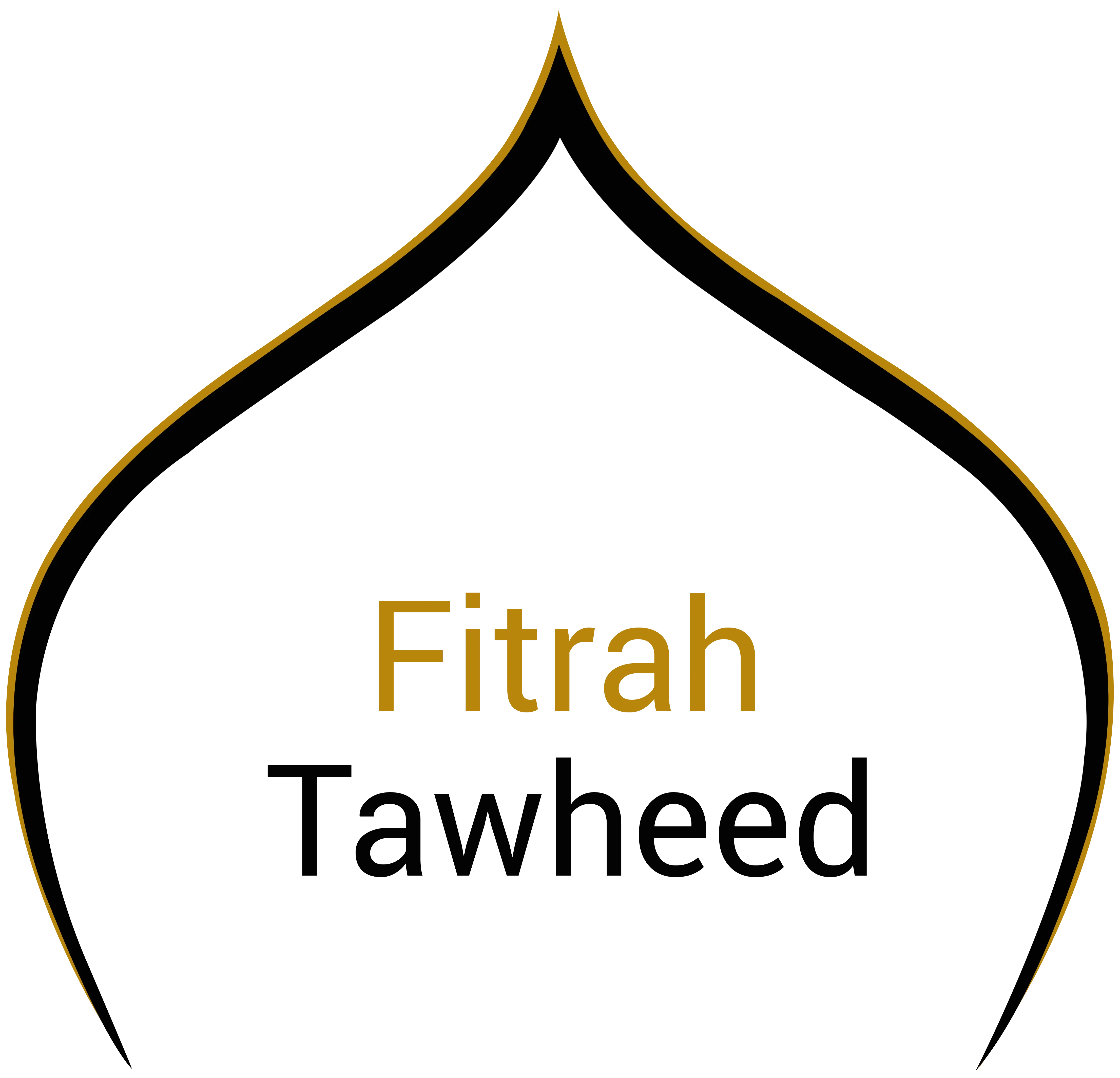
Orange color for men in Islam
There are many colors in Islam which are permissible to wear for men. Such colors are red, yellow, black, white, green etc.
Men are not allowed to wear vibrant orange color. This has been narrated to be a color reserved for women only. However, men can wear another specific type of orange shade which is darker and not vibrant.
Narrations speak about the prohibition of 'الْمُعَصْفَرَ', which is an Arabic word describing that which is dyed with safflower. The prohibition is on safflower dye for men, but also other dyes which produces the same color safflower produces.
The color safflower produces is for women, and also a color that resembles the robes of Buddhist monks. For this reason, men cannot wear vibrant shades of orange.
Prohibition of wearing clothes dyed with safflower
Safflower is called 'usfur (عصفر)' in Arabic, not to be confused with the word زعفران (saffron). عصفر produces an orange color whereas زعفران produces a yellow color.
The narrations below discuss about clothes dyed with this, which word 'الْمُعَصْفَرَ' is used: that which is dyed with safflower.
 حَدَّثَنَا مُحَمَّدُ بْنُ الْمُثَنَّى، حَدَّثَنَا مُعَاذُ بْنُ هِشَامٍ، حَدَّثَنِي أَبِي، عَنْ يَحْيَى، حَدَّثَنِي مُحَمَّدُ بْنُ إِبْرَاهِيمَ بْنِ الْحَارِثِ، أَنَّ ابْنَ مَعْدَانَ، أَخْبَرَهُ أَنَّ جُبَيْرَ بْنَ نُفَيْرٍ أَخْبَرَهُ أَنَّ عَبْدَ اللَّهِ بْنَ عَمْرِو بْنِ الْعَاصِ أَخْبَرَهُ قَالَ رَأَى رَسُولُ اللَّهِ صلى الله عليه وسلم عَلَىَّ ثَوْبَيْنِ مُعَصْفَرَيْنِ فَقَالَ " إِنَّ هَذِهِ مِنْ ثِيَابِ الْكُفَّارِ فَلاَ تَلْبَسْهَا " .
حَدَّثَنَا مُحَمَّدُ بْنُ الْمُثَنَّى، حَدَّثَنَا مُعَاذُ بْنُ هِشَامٍ، حَدَّثَنِي أَبِي، عَنْ يَحْيَى، حَدَّثَنِي مُحَمَّدُ بْنُ إِبْرَاهِيمَ بْنِ الْحَارِثِ، أَنَّ ابْنَ مَعْدَانَ، أَخْبَرَهُ أَنَّ جُبَيْرَ بْنَ نُفَيْرٍ أَخْبَرَهُ أَنَّ عَبْدَ اللَّهِ بْنَ عَمْرِو بْنِ الْعَاصِ أَخْبَرَهُ قَالَ رَأَى رَسُولُ اللَّهِ صلى الله عليه وسلم عَلَىَّ ثَوْبَيْنِ مُعَصْفَرَيْنِ فَقَالَ " إِنَّ هَذِهِ مِنْ ثِيَابِ الْكُفَّارِ فَلاَ تَلْبَسْهَا " .
'Abdullah b. 'Amr b. al-As reported:
Allah's Messenger (ﷺ) saw me wearing two clothes dyed with safflower. whereupon he said: These are the clothes of the disbelievers, so do not wear them.
[Sahih Muslim 2077a]
 حَدَّثَنَا دَاوُدُ بْنُ رُشَيْدٍ، حَدَّثَنَا عُمَرُ بْنُ أَيُّوبَ الْمَوْصِلِيُّ، حَدَّثَنَا إِبْرَاهِيمُ بْنُ نَافِعٍ، عَنْ سُلَيْمَانَ الأَحْوَلِ، عَنْ طَاوُسٍ، عَنْ عَبْدِ اللَّهِ بْنِ عَمْرٍو، قَالَ رَأَى النَّبِيُّ صلى الله عليه وسلم عَلَىَّ ثَوْبَيْنِ مُعَصْفَرَيْنِ فَقَالَ " أَأُمُّكَ أَمَرَتْكَ بِهَذَا " . قُلْتُ أَغْسِلُهُمَا . قَالَ " بَلْ أَحْرِقْهُمَا " .
حَدَّثَنَا دَاوُدُ بْنُ رُشَيْدٍ، حَدَّثَنَا عُمَرُ بْنُ أَيُّوبَ الْمَوْصِلِيُّ، حَدَّثَنَا إِبْرَاهِيمُ بْنُ نَافِعٍ، عَنْ سُلَيْمَانَ الأَحْوَلِ، عَنْ طَاوُسٍ، عَنْ عَبْدِ اللَّهِ بْنِ عَمْرٍو، قَالَ رَأَى النَّبِيُّ صلى الله عليه وسلم عَلَىَّ ثَوْبَيْنِ مُعَصْفَرَيْنِ فَقَالَ " أَأُمُّكَ أَمَرَتْكَ بِهَذَا " . قُلْتُ أَغْسِلُهُمَا . قَالَ " بَلْ أَحْرِقْهُمَا " .
'Abdullah b. 'Amr b. al-As reported:
Allah's Messenger (ﷺ) saw me in two clothes dyed with safflower, whereupon he said: Has your mother ordered you to do so (as this color is for women)? And I said: I will wash them (remove its color). He said: Burn them.
[Sahih Muslim 2077c]
 أخبرنا عبد الرزاق عن معمر عن قتادة أن عمر بن الخطاب رأى على رجل ثوبا معصفرا فقال: دعوا هذه البراقات للنساء
أخبرنا عبد الرزاق عن معمر عن قتادة أن عمر بن الخطاب رأى على رجل ثوبا معصفرا فقال: دعوا هذه البراقات للنساء
المصنف - عبد الرزاق الصنعاني - ج ١١ - الصفحة ٧٨
Qatada narrated: 'Umar Ibn al-Khattab saw a man wearing safflower dyed clothes and said, leave this color for the women.
[Musannaf Abdurrazzaq 11/78]
 باب مَا جَاءَ فِي كَرَاهِيَةِ لُبْسِ الْمُعَصْفَرِ لِلرَّجُلِ وَالْقَسِّيِّ
باب مَا جَاءَ فِي كَرَاهِيَةِ لُبْسِ الْمُعَصْفَرِ لِلرَّجُلِ وَالْقَسِّيِّ
حَدَّثَنَا عَبَّاسُ بْنُ مُحَمَّدٍ الْبَغْدَادِيُّ، حَدَّثَنَا إِسْحَاقُ بْنُ مَنْصُورٍ، أَخْبَرَنَا إِسْرَائِيلُ، عَنْ أَبِي يَحْيَى، عَنْ مُجَاهِدٍ، عَنْ عَبْدِ اللَّهِ بْنِ عَمْرٍو، قَالَ مَرَّ رَجُلٌ وَعَلَيْهِ ثَوْبَانِ أَحْمَرَانِ فَسَلَّمَ عَلَى النَّبِيِّ صلى الله عليه وسلم فَلَمْ يَرُدَّ النَّبِيُّ صلى الله عليه وسلم عَلَيْهِ السَّلاَمَ . قَالَ أَبُو عِيسَى هَذَا حَدِيثٌ حَسَنٌ غَرِيبٌ مِنْ هَذَا الْوَجْهِ . وَمَعْنَى هَذَا الْحَدِيثِ عِنْدَ أَهْلِ الْعِلْمِ أَنَّهُمْ كَرِهُوا لُبْسَ الْمُعَصْفَرِ وَرَأَوْا أَنَّ مَا صُبِغَ بِالْحُمْرَةِ بِالْمَدَرِ أَوْ غَيْرِ ذَلِكَ فَلاَ بَأْسَ بِهِ إِذَا لَمْ يَكُنْ مُعَصْفَرًا .
Narrated 'Abdullah bin 'Amr ibn al-'Aas:
"A man passed by while wearing two red garments. He gave Salam to the Prophet (ﷺ) but he did not return the Salam."
Imam Tirmidhi commented: "This hadith is Hasan Gharib. The explanation of this Hadith according to the people of knowledge is that they hated wearing clothes dyed with safflower. And their opinion was that there is nothing wrong with what is dyed red with ochre or anything else as long as it is not safflower."
[Sunan Tirmidhi 2807]
 أَخْبَرَنِي إِبْرَاهِيمُ بْنُ يَعْقُوبَ، قَالَ حَدَّثَنَا الْحَسَنُ بْنُ مُوسَى، قَالَ حَدَّثَنَا شَيْبَانُ، عَنْ يَحْيَى، أَخْبَرَنِي خَالِدُ بْنُ مَعْدَانَ، أَنَّ ابْنَ حُنَيْنٍ، حَدَّثَهُ أَنَّ عَلِيًّا قَالَ إِنَّ رَسُولَ اللَّهِ صلى الله عليه وسلم نَهَى عَنْ ثِيَابِ الْمُعَصْفَرِ وَعَنِ الْحَرِيرِ وَأَنْ يَقْرَأَ وَهُوَ رَاكِعٌ وَعَنْ خَاتَمِ الذَّهَبِ .
أَخْبَرَنِي إِبْرَاهِيمُ بْنُ يَعْقُوبَ، قَالَ حَدَّثَنَا الْحَسَنُ بْنُ مُوسَى، قَالَ حَدَّثَنَا شَيْبَانُ، عَنْ يَحْيَى، أَخْبَرَنِي خَالِدُ بْنُ مَعْدَانَ، أَنَّ ابْنَ حُنَيْنٍ، حَدَّثَهُ أَنَّ عَلِيًّا قَالَ إِنَّ رَسُولَ اللَّهِ صلى الله عليه وسلم نَهَى عَنْ ثِيَابِ الْمُعَصْفَرِ وَعَنِ الْحَرِيرِ وَأَنْ يَقْرَأَ وَهُوَ رَاكِعٌ وَعَنْ خَاتَمِ الذَّهَبِ .
It was narrated from Ibn Hunain, that 'Ali said that: The Messenger of Allah [SAW] forbade garments dyed with safflower, and from silk, and reciting Qur'an while he is bowing, and from gold rings.
[Sunan an-Nasa'i 5272]
 حدثنا أبو بكر قال حدثنا علي عن يزيد بن أبي زياد عن الحسن بن سهيل عن ابن عمر قال: نهى رسول الله صلى الله عليه وسلم عن المفدم، قال يزيد: قلت للحسن: ما المفدم؟ قال:
المشبع بالعصفر.
حدثنا أبو بكر قال حدثنا علي عن يزيد بن أبي زياد عن الحسن بن سهيل عن ابن عمر قال: نهى رسول الله صلى الله عليه وسلم عن المفدم، قال يزيد: قلت للحسن: ما المفدم؟ قال:
المشبع بالعصفر.
المصنف - ابن أبي شيبة الكوفي - ج ٦ - الصفحة ١٧
Ibn 'Umar narrated: The Messenger of Allah [SAW] forbade al-mufaddam. Al-Hasan ibn Suhayl added: Al-mufaddam is that which is saturated and filled with safflower (vibrant orange).
[Musannaf Ibn Abi Shaybah 6/17]
 حدثنا أبو بكر قال حدثنا محمد بن عبد الله الأسدي عن عبيد الله بن عبد الله بن موهب قال: حدثني عمي عن أبي هريرة عن عثمان قال: نهى رسول الله صلى الله عليه وسلم عن المعصفر.
حدثنا أبو بكر قال حدثنا محمد بن عبد الله الأسدي عن عبيد الله بن عبد الله بن موهب قال: حدثني عمي عن أبي هريرة عن عثمان قال: نهى رسول الله صلى الله عليه وسلم عن المعصفر.
المصنف - ابن أبي شيبة الكوفي - ج ٦ - الصفحة ١٧
'Uthman ibn 'Affan narrated: The Messenger of Allah [SAW] forbade clothing dyed with safflower.
[Musannaf Ibn Abi Shaybah 6/17]
 حدثنا أبو بكر قال حدثنا وكيع عن فضيل عن نافع عن ابن عمر: رأى على ابن له معصفرا فنهاه.
حدثنا أبو بكر قال حدثنا وكيع عن فضيل عن نافع عن ابن عمر: رأى على ابن له معصفرا فنهاه.
[المصنف - ابن أبي شيبة الكوفي - ج ٦ - الصفحة ١٧]
Nafi' narrated: Ibn 'Umar saw his son wearing safflower dyed clothes so he forbade him from that.
[Musannaf Ibn Abi Shaybah 6/17]
However, some scholars among the Salaf Saliheen like Ibrahim al-Nakhai, Al-Sha'bi, Imam Malik and others permitted the wearing of safflower dyed clothes for men.
They permitted it due to not knowing the narrations prohibiting it, as they only knew of the narration of 'Ali where he said it was only prohibited for himself.
 حدثنا أبو بكر قال حدثنا وكيع عن أسامة بن زيد عن عبد الله بن حنين قال:
سمعت عليا يقول: نهاني رسول الله صلى الله عليه وسلم. ولا أقول نهاكم عن لبس المعصفر.
حدثنا أبو بكر قال حدثنا وكيع عن أسامة بن زيد عن عبد الله بن حنين قال:
سمعت عليا يقول: نهاني رسول الله صلى الله عليه وسلم. ولا أقول نهاكم عن لبس المعصفر.
[المصنف - ابن أبي شيبة الكوفي - ج ٦ - الصفحة ١٦]
Narrated 'Ali:
The Messenger of Allah (ﷺ) forbade me from wearing clothes dyed with safflower, but I do not say he forbade you as well.
[Musannaf Ibn Abi Shaybah 6/16]
So upon hearing this narration, many scholars in Kufa like Ibrahim al-Nakhai and al-Sha'bi wore this color without objecting to it. This was also spread to Medinah, where the scholars adopted it as something permissible due to them not knowing of anything prohibiting safflower dyed clothes.
 حدثنا أبو بكر قال حدثنا وكيع عن العلاء بن عبد الكريم قال : رأيت على إبراهيم ثوبا معصفرا.
حدثنا أبو بكر قال حدثنا وكيع عن العلاء بن عبد الكريم قال : رأيت على إبراهيم ثوبا معصفرا.
[المصنف - ابن أبي شيبة الكوفي - ج ٦ - الصفحة ١٥]
Al-'Ala ibn 'Abdulkarim narrated: I saw Ibrahim al-Nakhai wear a thobe dyed with safflower.
[Musannaf Ibn Abi Shaybah 6/15]
 قال: أخبرنا عبد الله بن إدريس قال: سمعتُ ليثًا يَذْكر قال: رأيتُ الشعبي وما أدري ملحفته أشدّ حمرة أو لحيته.
قال: أخبرنا عبد الله بن إدريس قال: سمعتُ ليثًا يَذْكر قال: رأيتُ الشعبي وما أدري ملحفته أشدّ حمرة أو لحيته.
[الطبقات الكبرى - محمد بن سعد - ج ٦ - الصفحة ٢٥٢]
Layth Ibn Sa'd narrated: I saw Al-Sha'bi and I did not know which one was more red: his cloak or his beard.
[Tabaqat al-Kubra 6/252]
 أخبرنا عبد الرزاق عن معمر عن هشام بن عروة قال: كان أبي يلبس ملحفة حمراء صبغت بالعصفر، حتى مات.
أخبرنا عبد الرزاق عن معمر عن هشام بن عروة قال: كان أبي يلبس ملحفة حمراء صبغت بالعصفر، حتى مات.
[المصنف - عبد الرزاق الصنعاني - ج ١١ - الصفحة ٧٦]
Hisham Ibn 'Urwah narrated: My father ('Urwah ibn al-Zubayr) used to wear a red cloak dyed with safflower till his death.
[Musannaf Abdurrazzaq 11/76]
 ٢٤٧٢١ - حَدَّثَنَا أَبُو بَكْرٍ قَالَ: حَدَّثَنَا أَبُو أُسَامَةَ، عَنِ ابْنِ عَوْنٍ، عَنْ مُحَمَّدٍ: «كَانَ لَا يَرَى بَأْسًا بِلُبْسِ الرَّجُلِ الثَّوْبَ الْمَصْبُوغَ، بِالْعُصْفُرِ وَالزَّعْفَرَانِ»
٢٤٧٢١ - حَدَّثَنَا أَبُو بَكْرٍ قَالَ: حَدَّثَنَا أَبُو أُسَامَةَ، عَنِ ابْنِ عَوْنٍ، عَنْ مُحَمَّدٍ: «كَانَ لَا يَرَى بَأْسًا بِلُبْسِ الرَّجُلِ الثَّوْبَ الْمَصْبُوغَ، بِالْعُصْفُرِ وَالزَّعْفَرَانِ»
[ص158 - كتاب المصنف ابن أبي شيبة]
Ibn 'Awn narrated: Muhammad Ibn Sireen did not believe anything to be wrong with wearing clothes dyed with safflower (orange) or saffron (yellow).
[Musannaf Ibn Abi Shaybah page 158]
 قال يحيى: وسمعت مالكا يقول في الملاحف المعصفرة في البيوت للرجال، وفي الأفنية.
قال: لا أعلم من ذلك شيئا حراما. وغير ذلك من اللباس أحب إلى.
قال يحيى: وسمعت مالكا يقول في الملاحف المعصفرة في البيوت للرجال، وفي الأفنية.
قال: لا أعلم من ذلك شيئا حراما. وغير ذلك من اللباس أحب إلى.
[كتاب الموطأ - الإمام مالك - ج ٢ - الصفحة ٩١٢]
Imam Malik said:
"I do not know of anything proving the wearing of safflower dyed clothes to be haram for men in the house or in the yard. And other colored clothes are more beloved to me."
[Al-Muwatta 2/912]
 ولا بأس بلبس المُعَصْفَر
ولا بأس بلبس المُعَصْفَر
[ص521 - كتاب المختصر الصغير لابن عبد الحكم خلافيات في الفقه]
Ibn Abdul-Hakam al-Maliki said:
"And there is nothing wrong in wearing clothes dyed with safflower."
[Al-Mukhtasar al-Saghir - Ibn Abdul-Hakam - Page 521]
 ٢٤٧٢٣ - حَدَّثَنَا أَبُو بَكْرٍ قَالَ: حَدَّثَنَا وَكِيعٌ، عَنْ حَمَّادِ بْنِ زَيْدٍ، عَنْ عَاصِمِ ابْنِ بَهْدَلَةَ، قَالَ: " أَدْرَكْتُ أَقْوَامًا كَانُوا يَتَّخِذُونَ هَذَا اللَّيْلَ جَمَلًا يَلْبَسُونَ الْمُعَصْفَرَ مِنْهُمْ: أَبُو وَائِلٍ "
٢٤٧٢٣ - حَدَّثَنَا أَبُو بَكْرٍ قَالَ: حَدَّثَنَا وَكِيعٌ، عَنْ حَمَّادِ بْنِ زَيْدٍ، عَنْ عَاصِمِ ابْنِ بَهْدَلَةَ، قَالَ: " أَدْرَكْتُ أَقْوَامًا كَانُوا يَتَّخِذُونَ هَذَا اللَّيْلَ جَمَلًا يَلْبَسُونَ الْمُعَصْفَرَ مِنْهُمْ: أَبُو وَائِلٍ "
[الطبقات الكبرى - محمد بن سعد - ج ٦ - الصفحة ٢٥٢]
Ibn Bahdalah narrated: I saw a people on this beautiful night wearing safflower dyed clothes, and one of them was Abu Wael (Shaqiq ibn Salamah).
[Tabaqat al-Kubra 6/252]
Orange color for men
There are many shades of orange, the vibrant ones are for women, which makes it haram for men to wear.



However, a man can wear a specific shade of orange that is more brownish. Take for example the color of pottery or bricks.
The Salaf Saliheen used to wear this shade of orange, and it was deemed acceptable. This shade of orange is called (مشق). It is a color produced from red ochre (natural dye).
Clothes dyed with red ochre produce a more brownish shade to the orange color, which makes it less vibrant.
 Safflower
Produces vibrant orange shades
Safflower
Produces vibrant orange shades
 Red ochre
Produces shades of orange resembling pottery
Red ochre
Produces shades of orange resembling pottery
 عِنْدَ أَهْلِ الْعِلْمِ أَنَّهُمْ كَرِهُوا لُبْسَ الْمُعَصْفَرِ وَرَأَوْا أَنَّ مَا صُبِغَ بِالْحُمْرَةِ بِالْمَدَرِ أَوْ غَيْرِ ذَلِكَ فَلاَ بَأْسَ بِهِ إِذَا لَمْ يَكُنْ مُعَصْفَرًا
عِنْدَ أَهْلِ الْعِلْمِ أَنَّهُمْ كَرِهُوا لُبْسَ الْمُعَصْفَرِ وَرَأَوْا أَنَّ مَا صُبِغَ بِالْحُمْرَةِ بِالْمَدَرِ أَوْ غَيْرِ ذَلِكَ فَلاَ بَأْسَ بِهِ إِذَا لَمْ يَكُنْ مُعَصْفَرًا
[سنن الترمذي ٢٨٠٧]
Imam Tirmidhi said:
"According to the people of knowledge is that they hate wearing clothes dyed with safflower. And their opinion is that there is nothing wrong with what is dyed red with ochre or anything else as long as it is not safflower."
[Sunan Tirmidhi 2807]
 وحدثني عن مالك، عن نافع، أن عبد الله بن عمر كان يلبس الثوب المصبوغ بالمشق. والمصبوغ بالزعفران.
وحدثني عن مالك، عن نافع، أن عبد الله بن عمر كان يلبس الثوب المصبوغ بالمشق. والمصبوغ بالزعفران.
[كتاب الموطأ - الإمام مالك - ج ٢ - الصفحة ٩١١]
Nafi' narrated: Ibn 'Umar used to wear a thobe dyed with red ochre and a thobe dyed with saffron (yellow).
[Al-Muwatta 2/911]
 حَدَّثَنَا سُلَيْمَانُ بْنُ حَرْبٍ، حَدَّثَنَا حَمَّادٌ، عَنْ أَيُّوبَ، عَنْ مُحَمَّدٍ، قَالَ كُنَّا عِنْدَ أَبِي هُرَيْرَةَ وَعَلَيْهِ ثَوْبَانِ مُمَشَّقَانِ مِنْ كَتَّانٍ فَتَمَخَّطَ فَقَالَ بَخْ بَخْ أَبُو هُرَيْرَةَ يَتَمَخَّطُ فِي الْكَتَّانِ، لَقَدْ رَأَيْتُنِي وَإِنِّي لأَخِرُّ فِيمَا بَيْنَ مِنْبَرِ رَسُولِ اللَّهِ صلى الله عليه وسلم إِلَى حُجْرَةِ عَائِشَةَ مَغْشِيًّا عَلَىَّ، فَيَجِيءُ الْجَائِي فَيَضَعُ رِجْلَهُ عَلَى عُنُقِي، وَيُرَى أَنِّي مَجْنُونٌ، وَمَا بِي مِنْ جُنُونٍ، مَا بِي إِلاَّ الْجُوعُ.
حَدَّثَنَا سُلَيْمَانُ بْنُ حَرْبٍ، حَدَّثَنَا حَمَّادٌ، عَنْ أَيُّوبَ، عَنْ مُحَمَّدٍ، قَالَ كُنَّا عِنْدَ أَبِي هُرَيْرَةَ وَعَلَيْهِ ثَوْبَانِ مُمَشَّقَانِ مِنْ كَتَّانٍ فَتَمَخَّطَ فَقَالَ بَخْ بَخْ أَبُو هُرَيْرَةَ يَتَمَخَّطُ فِي الْكَتَّانِ، لَقَدْ رَأَيْتُنِي وَإِنِّي لأَخِرُّ فِيمَا بَيْنَ مِنْبَرِ رَسُولِ اللَّهِ صلى الله عليه وسلم إِلَى حُجْرَةِ عَائِشَةَ مَغْشِيًّا عَلَىَّ، فَيَجِيءُ الْجَائِي فَيَضَعُ رِجْلَهُ عَلَى عُنُقِي، وَيُرَى أَنِّي مَجْنُونٌ، وَمَا بِي مِنْ جُنُونٍ، مَا بِي إِلاَّ الْجُوعُ.
Narrated Muhammad ibn Sireen:
We were with Abu Huraira while he was wearing two linen garments dyed with red ochre. He wiped his nose with his garment, saying (to himself), "Fantastic! Fantastic! Abu Huraira is cleaning his nose with linen! There came a time when I would fall senseless between the pulpit of Allah's Messenger (ﷺ) and `Aisha's dwelling whereupon a passerby would come and put his foot on my neck, considering me a mad man, but in fact, I had no madness, I suffered nothing but hunger."
[Sahih al-Bukhari 7324]
 حدثنا أبو بكر قال ثنا يحيى بن عبيد قال: رأيت على طاوس ثوبين ممشقين [بطين] وهو محرم.
حدثنا أبو بكر قال ثنا يحيى بن عبيد قال: رأيت على طاوس ثوبين ممشقين [بطين] وهو محرم.
[المصنف - ابن أبي شيبة الكوفي - ج ٤ - الصفحة ٢١٧]
Yahya ibn 'Ubayd narrated: I saw Tawus wearing clothes dyed with red ochre while he was Muhrim.
[Musannaf Ibn Abi Shaybah 4/217]
 حدثنا أبو بكر قال ثنا وكيع عن حزام بن هشام قال: رأيت على عمر بن عبد العزيز ثوبين ممشقين وهو محرم.
حدثنا أبو بكر قال ثنا وكيع عن حزام بن هشام قال: رأيت على عمر بن عبد العزيز ثوبين ممشقين وهو محرم.
[المصنف - ابن أبي شيبة الكوفي - ج ٤ - الصفحة ٢١٨]
Hazim ibn Hisham narrated: I saw Umar Ibn Abdul-'Aziz wearing clothes dyed with red ochre while he was Muhrim.
[Musannaf Ibn Abi Shaybah 4/218]
So it is permissible for men to wear the darker shades of orange. This shade will not resemble the color of women or of Buddhist or Hindu monks, which makes it permissible to wear for men.




